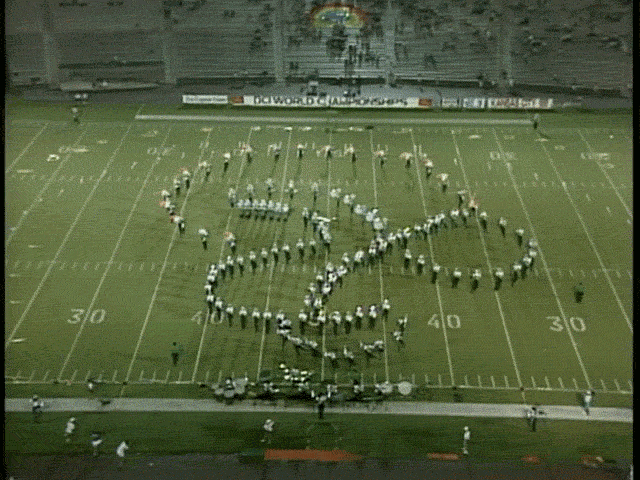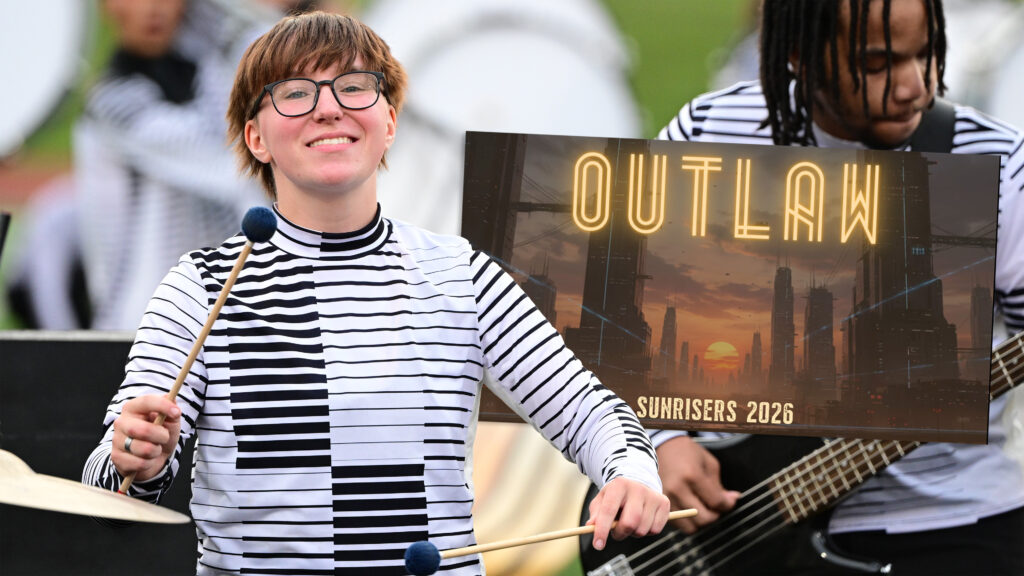The 1987 Drum Corps International World Championships at the University of Wisconsin’s Camp Randall Stadium became the first of such events to be held in the same location three years in a row.
This year the Garfield Cadets pulled off a slim victory with an “Appalachian Spring”-inspired production that defeated the Santa Clara Vanguard by a tenth of a point. Vanguard, which delivered a costumed Russian spectacular, had lost only two shows all season. Remarkably, the Cadets had earlier lost three shows to Spirit of Atlanta, a corps that would finish the season more than 10 points behind in 10th place.
1987 marked the first time the Bluecoats earned a spot among the top-12 corps advancing to the Finals, after the Canton, Ohio corps impressively moved up 13 placements between 1985 to 1986.

In 1986, the Cavaliers managed to pop into the top-three in the Finals competition for the first time. The 1987 corps managed to repeat this accomplishment, topping the fourth-place Blue Devils for the first time in 15 years. Until two weeks before the World Championships, the Cavaliers had won all of its contests; then slipped to fifth place in the Prelims in Madison, which broke a streak of 66 straight top-three finishes.
Visually, the corps’ 1987 production further crystallized the distinctive form of geometric progressions that future DCI Hall of Fame member Steve Brubaker had been developing since taking over drill writing responsibilities for the corps four years earlier.
Musically, for the second year in a row the corps presented a refined symphonic style largely relying on modern concert band music.

The production opened with Claude T. Smith’s “Festival Variations,” a work commissioned by the United States Air Force Band and premiered at the 50th anniversary conference of MENC (now NAfME) in San Antonio. Since the success of his first published composition, “Emperata Overture,” in 1964, Smith was known as one of America’s most renowned composers for wind bands.
The work was chock full of spectacularly difficult musical passages and a plethora of quick wind runs that rapidly moved up and down the melodic scale. It also contained several insertions of odd time signatures that Smith wrote into practically all his works, time signatures that would appear out of nowhere and be just as quickly gone.
Next came John Barnes Chance’s “Variations on a Korean Folk Song” which returned from the corps’ 1986 production. Chance wrote the piece in the mid-1960s, basing it on a Korean folk melody he heard while stationed in Korea with the Eighth U.S. Army Band during the 1950s. That melody, “Arirang,” is Korean for “rolling hills.” Chance took the pentatonic (five-note scale) melody and added Western harmonies, creating one of the most popular, best-selling works ever published for wind band.

As in 1986, the Cavaliers opened the work with the brass players facing backfield. Unaccompanied by percussion, only chimes and vibes joined in for an occasional “ding.” The arrangement then went into a short mixed-meter original percussion feature written by staff arrangers James Campbell and Kevin Lepper, with color guard members utilizing yellow-fringed hoops as a visual accent.
This segment ended with the brass players set up in “The Dragon,” a drill formation where corps members slithered in and out of a giant squiggle around the left 35-yard line of the football field. That form, presented during the section that Chance provided the style instruction, “Con Islancio” (with impetuousness), became one of Brubaker’s signature drill maneuvers.
The closing number featured David Holsinger’s “Liturgical Dances,” commissioned in 1981 for the 75th anniversary of the Phi Mu Alpha music fraternity chapter at Central Methodist University in Missouri. It was the same “Sinfonia” chapter that Holsinger was a member of during his college days. Holsinger describes the work as reflecting his days at the university, as being “both poignant and reflective, classic and modern, rambunctious and reflective.”

The piece opened with a mysterious backfield chorale that built intensity by changing one pitch of each chord at a time, creating a sinister effect. When the brass players turned around, the audio level was still quite subdued, but quickly picked up volume as the corps members marched forward at a slow tempo, adding to the almost unbearable tension.
Next was a rhythmic volley of machine gun-like horn stabs, angry and volatile, allowing the color guard members to let loose with a gymnastic sense of athleticism. This resolved into a percussion break overlaying another musical build further relying on Holsinger’s technique of slowly altering chords. A company front formation pushed to the end of the show.
Finishing 1987 in third place, members of the Cavaliers would find themselves in a lower placement only one more year in 1988, before climbing their way to the corps’ very first World Championship title in 1992.
1987 Overview

Michael Boo was a member of the Cavaliers from 1975-1977. He wrote about the drum corps activity for more than 35 years while serving as a staff writer for various Drum Corps International projects. During his lifetime Boo wrote for numerous other publications including an honors-winning book on the history of figure skating. He also was an accomplished composer. Boo passed away in 2020 and was inducted into the DCI Hall of Fame posthumously in 2021.





